LEARNING TO BOOGIE IN WILLIAMSBURG (1857)
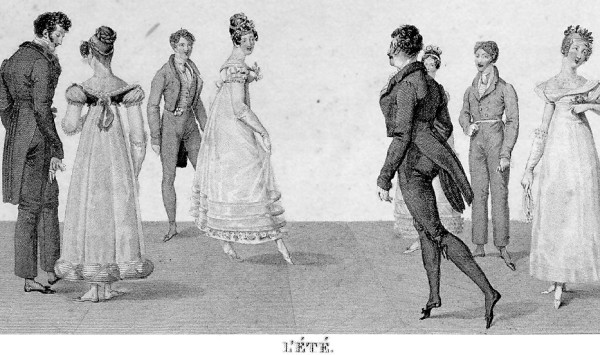
******************************************************************************************************************************** Brownstone Detectives investigates the history of our clients’ homes. The story you are about to read was composed from research conducted in the course of one of those investigations. Do you know the history of YOUR house? ******************************************************************************************************************************** People loved to dance back in the 1800s. Their dancing was mostly formal, almost mimicking a prepared act, but it took place in social settings allowing participants to display a good amount of that godly grace their lives often lacked. And people danced not just to exercise, but to socialize, to entertain themselves, and to hear about the latest news from their old and new friends. And everyone wanted to know the latest dances so that they were not embarrassed in such polite company, or so that they could – at the very least – discuss these dances intelligibly. THE 19TH CENTURY’S DISCO In 1857, the Lancers’ Quadrille was all the rage – and by “all the rage,” I mean “ALL THE RAGE.” It seemed that every dance school was teaching it, every tongue was wagging about it, and every newspaper dance academy ad offered its instruction. The Lancers’ Quadrille was a dance performed by four couples – it was a precursor of sorts to the square-dance, albeit a more refined square dance where everyone dressed supper classy and pretended to be nobility. SQUARE DANCIN’ IN BILLYBURG (W/PROF. TRENOR) In Williamsburgh, there existed Professor Trenor’s Private Dancing Academy, at No. 90 South Eighth Street near the East River. It was likely […]
OCEAN HILL VS. OCEAN HILL
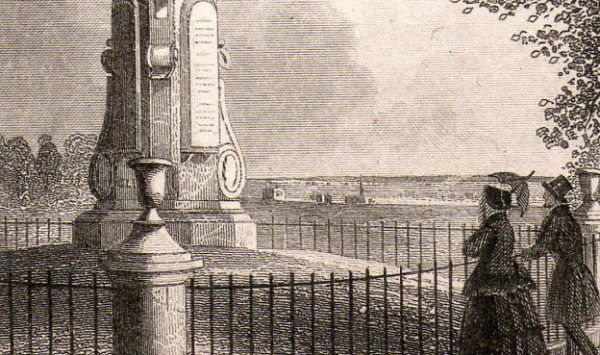
******************************************************************************************************************************** Brownstone Detectives investigates the history of our clients’ homes. The story you are about to read was composed from research conducted in the course of one of those investigations. Do you know the history of YOUR house? ******************************************************************************************************************************** Before there was Ocean Hill, there was…Ocean Hill…. Researching the history of this Brooklyn moniker, though, points you in the direction of two very different places with two very different histories. There is the original Ocean Hill in Green-Wood Cemetery, a geographic location used famously by George Washington during the American Revolution. And then, there is the Ocean Hill in the eastern section of Bedford-Stuyvesant, created by developers in 1860s Bushwick. The only characteristic the two places have had in common – other than the name – was a view of the ocean from their perches. But, now, even that is gone for one of them. OCEAN HILL – GREEN-WOOD CEMETERY Ocean Hill in Brooklyn’s City of the Dead, Green-Wood Cemetery, is likely as old as the cemetery itself, which dates from 1838. While it was not likely known as such during the American Revolution, the high vantage point was used by George Washington before the Battle of Brooklyn to observe the British forces, which were gathering to the south (and which would subsequently drive him out of New York). Ocean Hill according to Green-Wood Illustrated (issue 1), “is one of the most elevated spots in the Cemetery,” and “it occupies the north-eastern corner of the grounds.” “The sea itself,” the […]
THE “GOODFELLAS” OF CUMBERLAND STREET
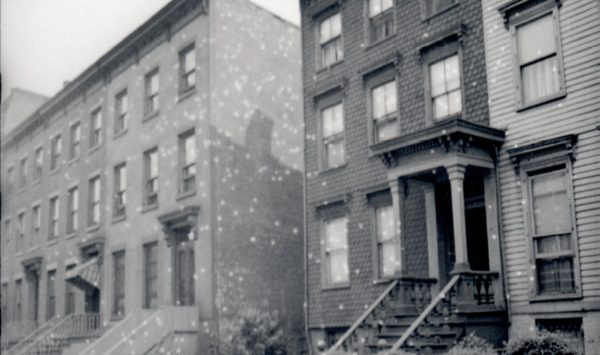
One of the Brownstone Detectives’ first House History Books, No. 231 Cumberland Street: The Story of a House, tells the story of an 1852 antebellum frame home just steps from Fort Greene Park. It’s an action-packed tome, replete with treachery, “poudrette,” “small art,” SROs, and the gangland figures from “Goodfellas.” Here is a brief timeline of the history of this single landmarked property, matched up with “spreads” from the book: THE HISTORY OF A BROOKLYN HOUSE The land beneath which No. 231 would someday rise, started out as a tobacco farm owned by the first Italian immigrant to New York, Pietre Cesare Alberti. The farmland would eventually be built upon in 1851-2, when builder John Ross constructed a row of three homes there. First owned by a woman with a tragic history, a melodrama involving treachery, another man, and an infant daughter – which became the gossip of the newspapers of the time – No. 231 was rented out throughout the the 1850s and 1860s, in addition to many returning Civil War veterans, to merchants and their small families. One of those merchants featured prominently in the founding of the Lafayette Avenue Presbytery Church. Before this, however, he had begun his interesting career as a Night Soil Man – starting a company which, amongst other “agricultural” endeavors, collected human excrement from the backyard privvies of Brooklyn, selling this “compost” to Long Island farmers as the appropriately – if euphemistically – named “poudrette.” The property was then owned by an immigrant, […]
THE “SCREAM” OF MACON STREET (1907)
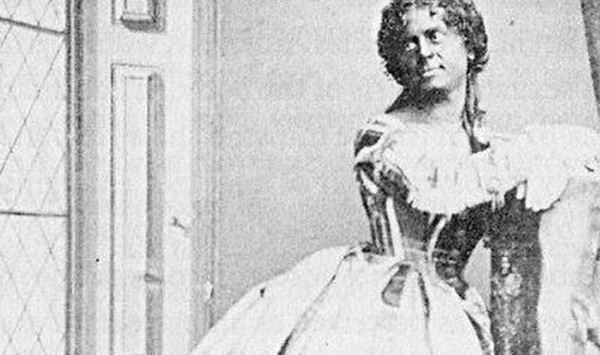
******************************************************************************************************************************** Brownstone Detectives investigates the history of our clients’ homes. The story you are about to read was composed from research conducted in the course of one of those investigations. Do you know the history of YOUR house? ******************************************************************************************************************************** Female “personators” seemed to bring out the passion in folks back in the day. Maybe there was less sexuality involved in the whole dressing-as-a-woman thing. Or maybe it was simply a matter of sexuality not mattering at all. Or, as some say, it was everything. But when “The Great Eugene” took the stage – and he took the stage always as a woman – men, in particular, seemed to find themselves singularly rapt in attention and admiration at the spell that the talented female personator was casting over them. BUILDING THE PERFECT IMPERSONATOR The Great Eugene, otherwise known simply as Eugene, was named Eugene D’ameli as a child. He was born on Manhattan in 1836, and, according to The New York Dramatic Mirror (the Broadway rag of the time), he made his first debut at the tender age of 17, playing what he would end up playing the rest of his career – a “prima donna” – a persona which “he improved and perfected until it was considered the best of its class.” His partner, “Johnny” Unsworth, of 700 Macon Street, recalled Eugene’s beginnings in the minstrel theatre. “Because he was so small and slight and built somewhat like a woman Gene started female impersonations, always in black face, as a […]
DRUNKS, URCHINS & FAST YOUNG MEN (1853)
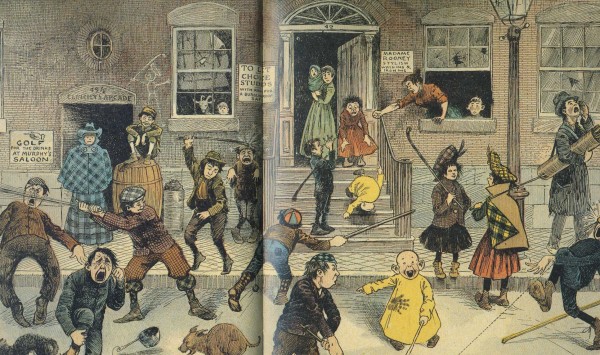
******************************************************************************************************************************** Brownstone Detectives investigates the history of our clients’ homes. The story you are about to read was composed from research conducted in the course of one of those investigations. Do you know the history of YOUR house? ******************************************************************************************************************************** “Ragged little boys, with dirty faces, trousers out behind, who sleep in coal boxes on door mats and stoops, pitching pennies and searching in the gutter.” So began a letter to the Brooklyn Daily Eagle in 1853 from an anonymous reader known simply as “Atlas.” Atlas was wondering why theater in New York did not spring from everyday life – as he saw it. And what he described painted a picture of Brooklyn life that has long drifted away, although it is still with us in other formats. Here are the characters that Atlas saw in Brooklyn in 1853: “Older boys with lips pouring out terrible oaths, disgusting obscenity, the fumes of penny cigars and cheap rum. “Old men tottering from dilapidated vermin-infected tenements, to smoke and drink at some low-roguery, whose greasy, fancy-colored decanters are so enchanting to every Godforsaken drunkard. “Slouchy, course-looking servant girls emptying slops into the gutter, and with pail in hand, stopping to exchange ribaldry with an idle neighbor, and retail scandal about the infidelities of their mistresses. “Faded women, with low-necked dresses, who indulge in very liberal views about virtue and chastity, with painted cheeks and brassy looking countenances, searching for verdant countrymen, to indulge with them in beastly licentiousness. “Lazy wives, with frouzy uncombed […]
The Burning of Mayor Wood’s Home (1855)
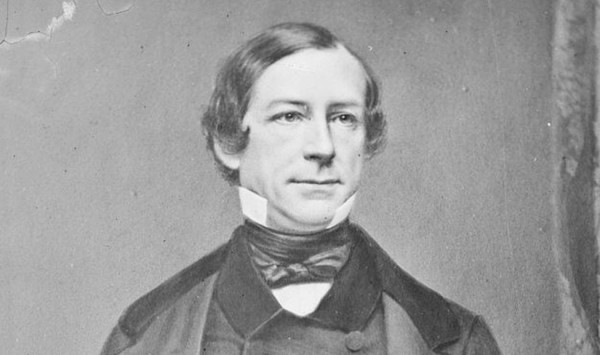
One of the buildings involved in yesterday’s horrific conflagration in the East Village had at one time been the residence of a New York City mayor infamous for his suggestion during the Civil War that New York City secede from the Union. According to an 1855 New York Times news-story, that mayor, Fernando Wood, lived at No. 121 Second Avenue (today, No. 123). Apparently, this 4-story and basement single family residence would be his home for many years. The fiercely political 2-term mayor was known for his leadership of Tammany Hall and for a system of massive patronage in city government that would eventually lead to emergence of Boss Tweed. Wood’s initial image, though, was one of anti-corruption, as, while living at his Second Avenue home, he was hailed for rooting out the extensive corruption that was rife within the New York Municipal Police Department at the time. According to the East Village/Lower East Side Historic District Designation Report, 123 Second Avenue was constructed in 1834. It subsequently underwent numerous alterations over the years, one of which likely occurred around 1911 when Second Avenue was famously widened – it was in that action that the building’s stoop and yard were removed. The numbering, also, was altered at some point. The current No. 121 Second Avenue was previously No. 119 Second Avenue, and today’s No. 123 Second Avenue (Wood’s residence) was then No. 121 Second Avenue. Follow @BrownstoneDetec ———————————————————————————————————————– The Brownstone Detectives The story you just read was composed from historical […]